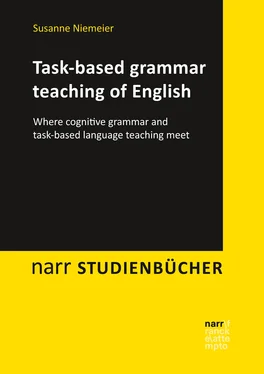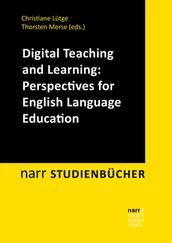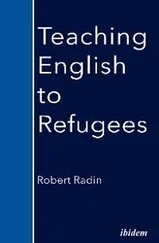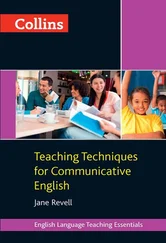Apart from the general types of task outlined above, the task topic is certainly of interest as well. R. ELLIS suggests that
… the guiding principles in the selection of content for tasks will be (1) topic familyarity and (2) intrinsic interest. Some appeal may also be made to (3) topic relevancy by predicting the general situations that learners may later find themselves in. (R. ELLIS 2003: 218)
As already mentioned earlier on, topics have to be motivating for the students in order for them to participate and to be willing to involve themselves in working on the task. However, a learner group is always heterogeneous, and therefore the learners’ areas of interest will vary. When planning a task, a teacher needs to keep in mind that the topic should be interesting for the majority of learners. Furthermore, as solving a task needs to draw on the learners’ world knowledge, the topic should be familiar enough to them to enable them to use their background knowledge, which will of course vary from individual to individual, so that the learner groups can pool their knowledge and profit from each other in this respect. R. ELLIS’ third point, although given as somewhat of an addendum in the quotation above, is actually equally important as the other two points he makes, because learners need to be prepared for situations beyond the classroom, for example, when spending time abroad in the culture(s) of their target language. They have to be able to ask for directions or to give directions, to obtain food and drink, to visit tourist attractions, to plan their travels and excursions, to interact with native speakers, just to give some few examples.
A well-designed task should furthermore allow the learners, at least as much as possible, to act in a self-determined way, and it should respect the learners’ individuality, i.e., their creative ways of thinking and their personal views in understanding and solving problems, which is of course easier for more advanced learners than for beginning learners. New ideas are appreciated, as there is not only one answer to every question and there is no set answer.
When planning grammar-related tasks, though, finding a suitable communicative topic is only half of the story, as the grammatical construction needs to fit into the topic as well. Therefore, the topic has to be well-structured and the language chosen for the pre-task phase as well as for the task instructions and potential worksheets needs to guide the learners into using the grammar construction in question. When the grammar topic is chosen first, situations in which the construction is used in natural communication behaviour need to be found which follow the above-quoted guidelines for suitable task contents. This task-finding sequence can also be turned around, as the teacher can first decide on a communicative situation, then see which grammatical constructions are frequently used in this situation and finally decide to focus on one of them.
After having provided an overview of diverse typologies of tasks and of ideas on what a task is, it may have become obvious that there is no definition which is shared by all researchers. Therefore, as a working definition, this book follows – at least to some extent – the definition provided by R. ELLIS:
A task is a workplan that requires learners to process language pragmatically in order to achieve an outcome that can be evaluated in terms of whether the correct or appropriate propositional content has been conveyed. To this end, it requires them to give primary attention to meaning and to make use of their own linguistic resources, although the design of the task may predispose them to choose particular forms. A task is intended to result in language use that bears a resemblance, direct or indirect, to the way language is used in the real world. (R. ELLIS 2003: 5f.)
What can be seen differently from what R. ELLIS claims is that in the approach of task-based grammar teaching, as proposed in this book, a task always wants the learners to choose particular forms, they not only “may” do so but instead have to do so. Whenever a certain grammatical structure is the leading competence to be acquired in a lesson, besides the communicative topic, this influences the task design because the teacher first of all needs to find situations in which the structure in question is used in natural communication and then has to select one of these situations and create a task which guides the learners towards using exactly this structure.
As a matter of caution, it should also be mentioned at this point that the task-based approach is not universally accepted but has also been criticised, especially since not all task-based language teaching proponents necessarily agree on what this approach entails nor, as mentioned above, do they all share the same definition of ‘task’, which makes it somewhat difficult to provide a coherent account of the approach. Criticism comes, for example, from RICHARDS/RODGERS (2001: 241), who lament “the absence of systematic grammatical or any other type of syllabus that characterises current versions of TBLT” and state that an evaluation of task performance is difficult. Furthermore, SEEDHOUSE (1999) claims that the language use in task-based lessons can be rather minimalistic and limited and therefore suggests that task-based learning should not be the only approach used. A counterargument, however, would be in this case that if the teacher offers rich input and prepares tasks that demand more than minimalistic language use from the learners by repeating useful words and phrases during the pre-task phase and by constructing tasks that demand a more sophisticated language use this danger may not be so imminent, especially when compared to PPP grammar lessons, where the learners’ use of the foreign language is normally limited to reading out isolated sentences.
COOK (2016: 289) argues that the task-based approach does not reach far enough beyond the classroom environment, by saying that “ …it (i.e., task-based teaching) does not appear concerned with overall teaching goals” and that
… there are higher goals to language teaching than fluency, accuracy and complexity, such as the beneficial effects on the students of the second language (personal goals), the usefulness of knowing a second language for the society (local goals) and the benefits for the world in general (international goals). (COOK 2016: 289)
These additional goals, however, are very far-fetched and it seems as if COOK (not exactly a supporter of the task-based approach) has tried to find whatever criticism he could think of. He certainly seems to be demanding far too much from one single approach to foreign language teaching and presumably no approach will ever be able to achieve all the goals mentioned in the quote above.
COOK does agree that fluency and accuracy may profit from the task-based approach and this is already a lot more than was reachable by previous approaches. Boiled down to a more manageable level, COOK’s “higher goals” can even be fulfilled by a task-based approach. In an ideal case, task-based instruction motivates the learners and can therefore be seen as an enrichment for their own lives (“personal goals”), and it can furthermore be useful outside of the classroom (“international goals”, although not necessarily for “the world in general” but rather for individual encounters in an international environment). Finally, as task-based foreign language teaching aims at contributing to the learners’ knowledge of and about the second language, even the “social goals” are addressed.
When planning a task, a teacher not only has to keep the target group’s interests, age and level of language skills in mind but also needs specific abilities. SKEHAN (1996, as quoted in MÜLLER-HARTMANN/SCHOCKER-VON DITFURTH 2011: 87) lists these as a) “an ability to select and sequence tasks for supplementary activities”, b) “the competence to organise, appropriately, pre- and post-task activities”, c) “a willingness to adapt task difficulty during the actual task phase” and d) “a sensitivity to individual differences and the capacity to adapt tasks to take account of differences in learner orientation”. In other words, not only do teachers have to be able to creatively plan and prepare tasks with their target audience in mind, but they have to show a certain degree of flexibility to adapt the task if it works out differently than planned.
Читать дальше












